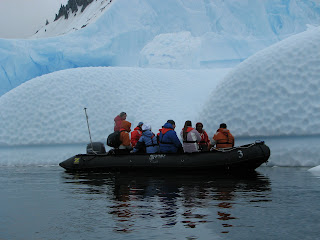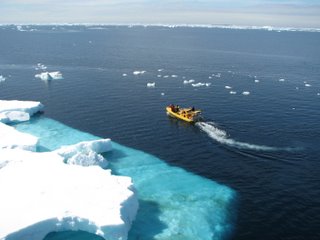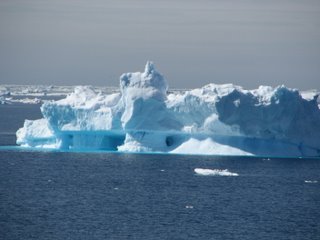Ten hours of flight time from New York’s JFK to Buenos Aires, the capital of Argentina. Six hours from Buenos Aires to Ushuaia, the Southernmost city in the world, on the island of Tierra de Fuego, at the end of South America (and part of the famous Patagonia in Argentina).
Ushuaia lies in the Andes Mountains, the longest mountain range along the Western part of South America. These mountains, actually connect South America to Antarctica (at the “finger” or the Antarctic Peninsula), it’s just that they are mostly covered by water (some of the tips creating islands along the way).
The passage from Ushuaia to Antarctica is known as the Drake Passage and forms part of the Southern Ocean, where the Pacific meets the Atlantic. It is home to the roughest seas in the world. Fortunately for us, we had a smooth sailing across the Drake.
We arrived to Elephant Island after a day across the Drake. This island is the first island along the Antarctic Peninsula. Around 1915, the famous explorer Sir Ernest Shackleton failed a transcontinental crossing of Antarctica when his ship, The Endurance, was trapped in the ice and sank. Stranded, he eventually led his entire crew of 27 men to Elephant Island (about 100 miles away). From there, he (and four others – one a trouble maker he didn’t want to leave behind) embarked on a 20’ boat to get help from the folks at South Georgia Island (about 800 miles across the Drake Passage!). I won’t spoil the end of the story; you should read Endurance by Alfred Lansing.
Thanks to some phenomenal expedition leaders and good weather, we were able explore many islands and the Antarctic Peninsula. We were even able to penetrate well below the Antarctic Circle, something not always possible. The pictures below are a rare glimpse and yet a poor highlight of the ineffable Antarctic world.
FUN FACTS:Antarctica is managed through a treaty of 43 nations. Seven of those countries, Argentina, Australia, Chile, France, New Zealand, Norway and the UK have historic claims on parts of the continent as national territory. The treaty preserves the status quo of the continent by neither recognizing nor rejecting the claims of these countries and by not allowing expansion, commercial activity, etc
· Average ice base – 1 to 2 miles deep!
· Area: About 1.5 times the size of the US
· Ice Free: Less than 1/2 %.
· Contains 90% of the world’s ice.
· Has 70% of the world’s fresh water (mostly ice)
· Tourism: Only about 25,000 per year!
Icebergs: Formed from the edge of glaciers as it breaks off when it reaches the sea. Icebergs are made of freshwater - from snow that has fallen over thousands of years. Annual weather conditions are responsible for their “stripes”. Dark blue layers come from snow in relatively warm/wet conditions when no air is trapped in the layer. Lighter layers come from very cold years. Only about 10% of a floating iceberg is above the water level. What’s below the water line is what sank the Titanic.
Sea-ice: Frozen seawater. Relatively thinner and more expansive; it’s what “icebreakers” cut across.
RECOMMENDED READING:The Last Place on Earth, by Roland Huntford
The race to the South Pole between Britain’s Robert Scott and Norway’s Amundson
Endurance, by Alfred Lansin
Sir. Ernest Shackleton’s epic voyage to Antarctica.
ANTARCTICA EXPEDITIONS:An experienced Expedition Leader makes all the difference. We were lucky to have more than one, including Dr. Roy “Fritz” Koerner, the first man to cross the frozen Arctic between Barrow, Alaska and Spitzbergen Island (Norway), passing the North Pole on the way. Bill Lishman, also known as “Father Goose” by becoming the first human to ‘fly’ with the birds (the movies Winged Migration and Fly Away Home were based on him), and Geoff Green a Canadian explorer who has led 70 expeditions to Antarctica. There are only six authorized places to land in the continent; our leaders made it possible to land on three.
CLOSING REMARKS:Antarctica’s full splendor and grandiosity await you.
Please click on the photos to enlarge.

Curtaining

Moss (unusual)

Paradise Bay

Twin Peaks

Below Antarctic Circle

Sea-ice

Below Antarctic Circle

Below Antarctic Circle

Below Antarctic Circle

Below Antarctic Circle

Below Antarctic Circle

Below Antarctic Circle

Below Antarctic Circle

Gentoo Feeding Chick

Gentoo Penguins

View from Port Lockroy

It works! Ship goes back and forth from Ushuaia to Port Lockroy

Iceberg (grounded on sea floor)

Gentoo Penguin

Chicks (mostly Gentoo's)

Multiyear Sea-ice below water line

Multiyear Sea-ice

Multiyear Sea-ice

Spot the penguins

Iceberg

Penguins Swimming

Glacier - Enlarge and spot the Zodiac (boat) for scale

Iceberg (to the right)

Young Fur Seal at Elephant Island

Elephant Island

Ushuaia
 On the way back from Antarctica, we were able to make a zodiac (inflatable motor boat) landing in Cape Horn Island. At the Southern tip of South America, this island is part of Chile. Many lives have been lost crossing the treacherous waters around Cape Horn. Most of the monuments and epigraphs on the island, as well as the statue of the Albatross (a magnificent seabird), have been dedicated to these lives... the Albatross metaphorically flying their souls forever. You can click on the photos to enlarge them.
On the way back from Antarctica, we were able to make a zodiac (inflatable motor boat) landing in Cape Horn Island. At the Southern tip of South America, this island is part of Chile. Many lives have been lost crossing the treacherous waters around Cape Horn. Most of the monuments and epigraphs on the island, as well as the statue of the Albatross (a magnificent seabird), have been dedicated to these lives... the Albatross metaphorically flying their souls forever. You can click on the photos to enlarge them. Cape Horn at distance.
Cape Horn at distance. Panoramic View from Cape Horn.
Panoramic View from Cape Horn. Zodiac Landing Site.
Zodiac Landing Site.

 Chilean Armed Forces Sign
Chilean Armed Forces Sign Photos of the various monuments and epigraphs at Cape Horn.
Photos of the various monuments and epigraphs at Cape Horn.




 A small church at the summit.
A small church at the summit.








































